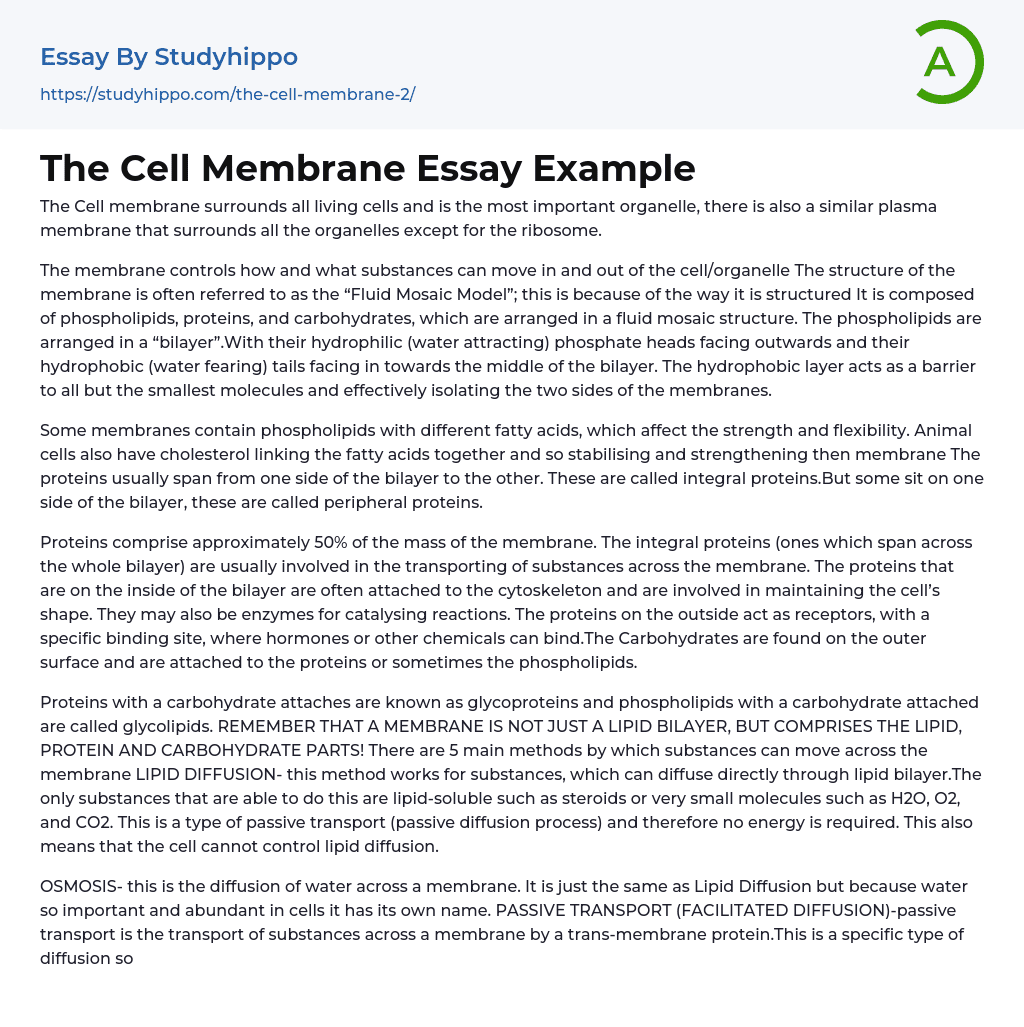The Cell membrane surrounds all living cells and is the most important organelle, there is also a similar plasma membrane that surrounds all the organelles except for the ribosome.
The membrane controls how and what substances can move in and out of the cell/organelle The structure of the membrane is often referred to as the “Fluid Mosaic Model”; this is because of the way it is structured It is composed of phospholipids, proteins, and carbohydrates, which are arranged in a fluid mosaic structure. The phospholipids are arranged in a “bilayer”.With their hydrophilic (water attracting) phosphate heads facing outwards and their hydrophobic (water fearing) tails facing in towards the middle of the bilayer. The hydrophobic layer acts as a barrier to all but the smallest molecules and effectively isolating the two sides of the membranes.
Some membranes conta
...in phospholipids with different fatty acids, which affect the strength and flexibility. Animal cells also have cholesterol linking the fatty acids together and so stabilising and strengthening then membrane The proteins usually span from one side of the bilayer to the other. These are called integral proteins.But some sit on one side of the bilayer, these are called peripheral proteins.
Proteins comprise approximately 50% of the mass of the membrane. The integral proteins (ones which span across the whole bilayer) are usually involved in the transporting of substances across the membrane. The proteins that are on the inside of the bilayer are often attached to the cytoskeleton and are involved in maintaining the cell’s shape. They may also be enzymes for catalysing reactions. The proteins on the outside act as receptors, with a specific binding site, where hormones or
other chemicals can bind.The Carbohydrates are found on the outer surface and are attached to the proteins or sometimes the phospholipids.
Proteins with a carbohydrate attaches are known as glycoproteins and phospholipids with a carbohydrate attached are called glycolipids. REMEMBER THAT A MEMBRANE IS NOT JUST A LIPID BILAYER, BUT COMPRISES THE LIPID, PROTEIN AND CARBOHYDRATE PARTS! There are 5 main methods by which substances can move across the membrane LIPID DIFFUSION- this method works for substances, which can diffuse directly through lipid bilayer.The only substances that are able to do this are lipid-soluble such as steroids or very small molecules such as H2O, O2, and CO2. This is a type of passive transport (passive diffusion process) and therefore no energy is required. This also means that the cell cannot control lipid diffusion.
OSMOSIS- this is the diffusion of water across a membrane. It is just the same as Lipid Diffusion but because water so important and abundant in cells it has its own name. PASSIVE TRANSPORT (FACILITATED DIFFUSION)-passive transport is the transport of substances across a membrane by a trans-membrane protein.This is a specific type of diffusion so the substance must contain the right protein. This also requires no energy.
Passive transport requires two types of protein. Channel proteins- these form a water-filled pore or channel in the membrane. This allows charged substances (eg ions) to diffuse across the membrane. Carrier Proteins- these have a binding site for a specific solute. Once it has bound the protein “flips” to allow the solute to enter/exit the membrane.
This means that the site is always open to one side of the membrane.The substance will only bind
where there is a high concentration and be released where there is a low concentration. ACTIVE TRANSPORT (or PUMPING)- This where the protein binds to the molecule on one side of the membrane, and then changes shape to deliver it to the other side. Because they are specific there is a different protein pump for every molecule to be transported.
Because the proteins are ATPase and catalyse the splitting of ATP they release energy, therefore making it an active process (requires energy). It also the ONLY method where a substance can be moved UP its concentration gradient.VESICLES- all the previous processes apply to only small molecules. This is the process used for larger molecules such as proteins, polysaccharides, and nucleotides and sometimes even whole cells. There are two types of way a vesicle can work.
Endocytosis- this is the transport of materials into cells. The membrane folds itself around the substance then pinches off to trap the substance inside it. Exocytosis- this is the reverse of endocytosis. The materials are transported out of the cell and are usually enclosed in a vesicle from the RER or the Golgi Body.
- Organic Chemistry essays
- Acid essays
- Calcium essays
- Chemical Bond essays
- Chemical Reaction essays
- Chromatography essays
- Ethanol essays
- Hydrogen essays
- Periodic Table essays
- Titration essays
- Chemical reactions essays
- Osmosis essays
- Carbohydrate essays
- Carbon essays
- Ph essays
- Diffusion essays
- Copper essays
- Salt essays
- Concentration essays
- Sodium essays
- Distillation essays
- Amylase essays
- Magnesium essays
- Acid Rain essays
- Mutation essays
- Bacteria essays
- Biotechnology essays
- Breeding essays
- Cell essays
- Cell Membrane essays
- Cystic Fibrosis essays
- Enzyme essays
- Human essays
- Microbiology essays
- Natural Selection essays
- Photosynthesis essays
- Plant essays
- Protein essays
- Stem Cell essays
- Viruses essays
- Agriculture essays
- Albert einstein essays
- Animals essays
- Archaeology essays
- Bear essays
- Biology essays
- Birds essays
- Butterfly essays
- Cat essays
- Charles Darwin essays




